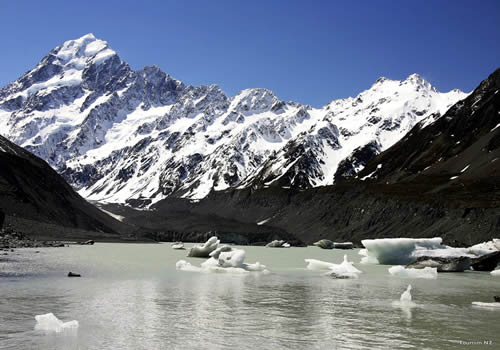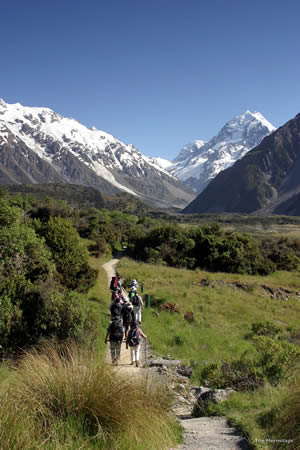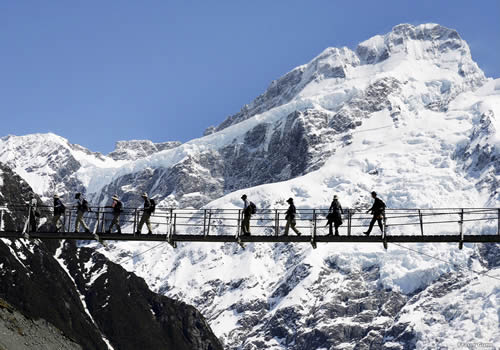- Home ›
- NZ National Parks ›
- Mount Cook National Park
Aoraki Mount Cook National Park New Zealand
Approximately 40 percent of Aoraki Mount Cook National Park, New Zealand, is covered with glaciers that wind their way through a unique alpine landscape where there are permanent snow fields in the Southern Alps.

End of the Hooker Valley Track. Hooker Glacier Lake - Photographer Fraser Gunn
The 26 km long Tasman Glacier is the largest glacier in New Zealand along with Aoraki / Mount Cook, the highest peak in New Zealand. There are also twenty three other peaks in this National Park that reach more than three thousand metres high!
There is a map of Mount Cook National Park below.
All New Zealand National Parks
With that brief description, Mount Cook may appear as if it's an inaccessible National Park. However, although there is an abundance of activities to suit experienced mountaineers, there are also plenty of activities where the less experienced outdoor enthusiasts have an opportunity to make the best of this stunning environment.
There is a multitude of short, long, and multi day walks and tours that take you through the native flora and herb fields, birds and animals to see, or alternatively you can enjoy scenic flights over the Alps and glaciers!
Related Content: Canterbury Region - National Parks List - Outdoor Safety Code
Activities in Aoraki Mount Cook National Park
Additional to the multi day tramping for experienced hikers, there are also ten one day or shorter walks in the area immediately round the Aoraki/Mount Cook Village and among the surrounding valleys. The more popular tracks taking approximately two hours return are; Hooker Valley, Kea Point, and Red Tarns Track.
Soak up the unique flora, native wildlife, and native birds on short walks and/or multi day tours through herb fields. If you have enough spare cash, scenic flights to glaciers by helicopter, plane, or hot air balloon offer unbelievable memories.
Alpine hikers and trampers with more experience can take challenging routes such as the three mountain passes over the Mueller Pass, Copland Pass, and Ball Pass.
For mountaineers the real challenge would be climbing Aoraki/Mount Cook, although there are plenty of other peaks to choose from that are equally challenging to climb. Some favourite peaks would be La Perouse, Elie de Beaumont, Sefton, Tasman, and Malte Brun.

Getting access to the glaciers by ski plane or helicopter is an option, with several choices for advanced skiers to experience such as Darwin, Murchison, and Bonney glaciers.
Experienced guides can take intermediate skiers down the Tasman Glacier and/or you explore the glaciers lake in a boat between October and May. Either way, you would never forget the ice caverns and formations that are part of these adventurous experiences leaving from Aoraki/Mount Cook airport.
Mount Cook National Park Accommodation

The nearest settlements are Lake Tekapo and Twizel, both of which have a range of facilities, options for accommodation and camping, cafes and restaurants.
Accommodation types range from camp sites to backpacker lodges, right up to luxury hotels. If you are looking for a hotel with views of Aoraki/Mount Cook, the Hermitage Hotel is the place famed for these views.
There are seventeen huts in the Aoraki Mount Cook National Park. Most of these huts are located with the purpose of provision for mountaineers’ accommodation. You pretty much need climbing experience and skills just to reach the huts!
If you are not a climbing enthusiast or mountaineer, Aoraki/Mount Cook Village has plenty of attractions for you too.
National Parks
New Zealand National Parks Full list of all national parks.
New Zealand Walks - Birds - Animals Unique native wildlife.
Land Outdoor Safety Code for New Zealand - Essential for outdoor safety.
Aoraki/Mount Cook National Park Map
Shared border with Westland Tai Poutini National Park
